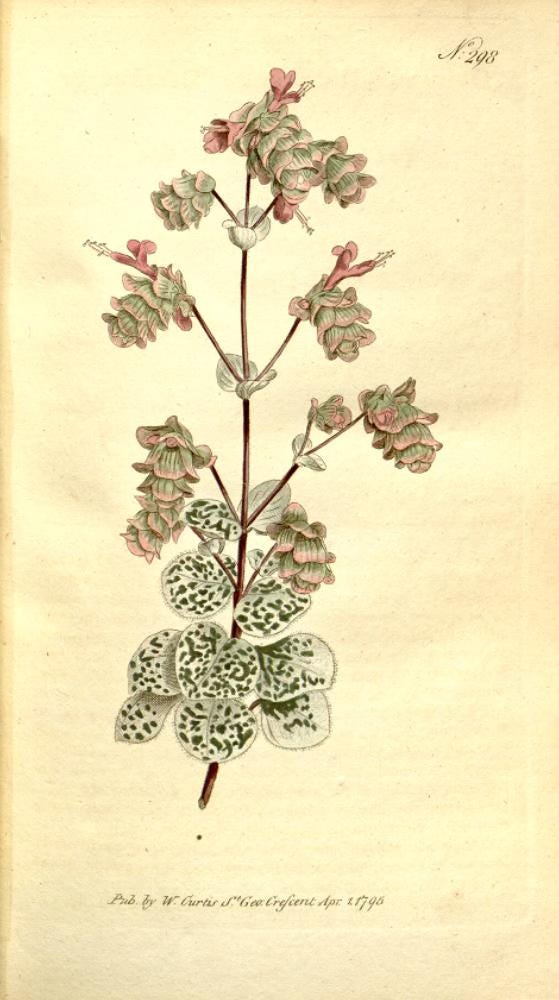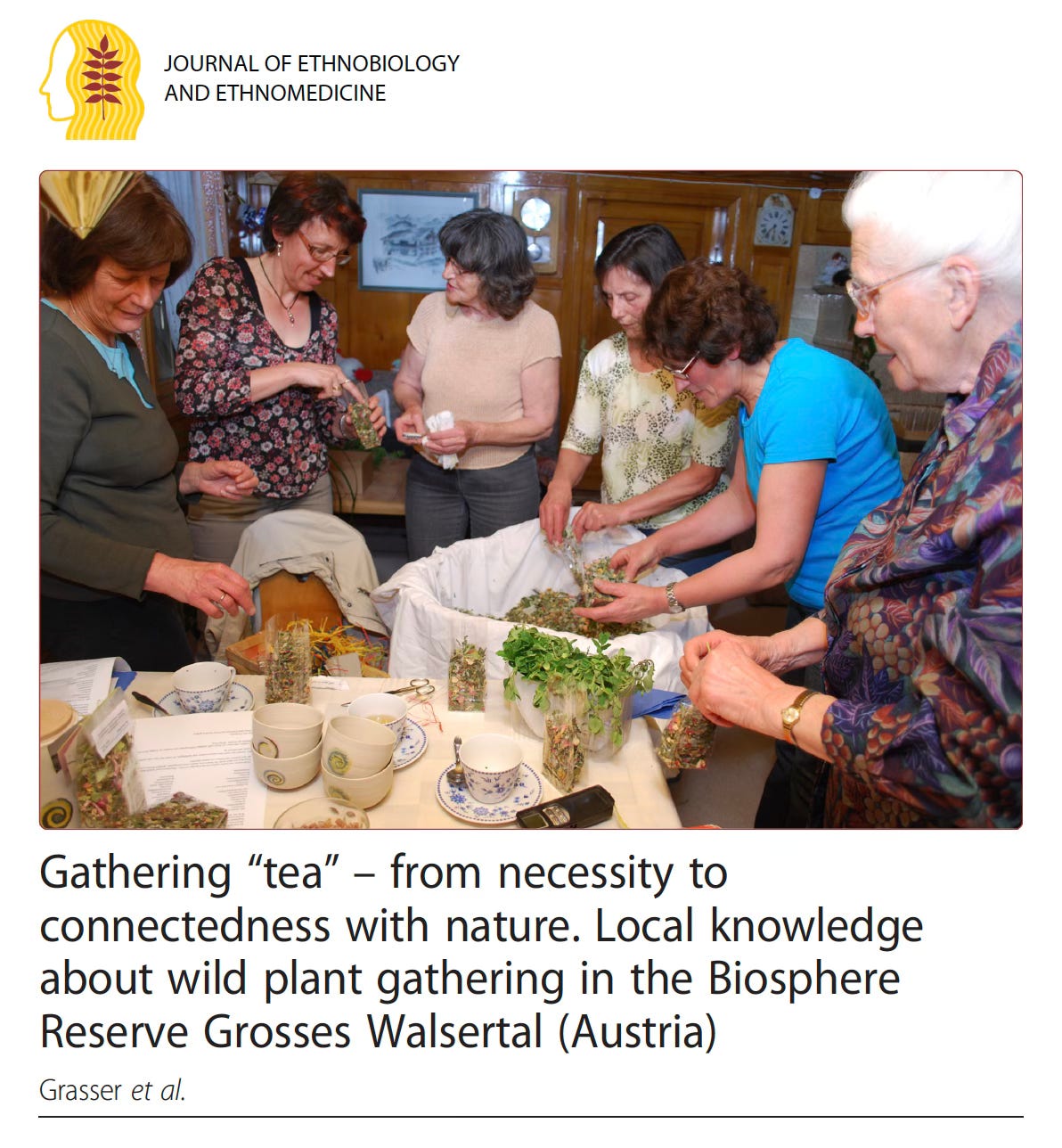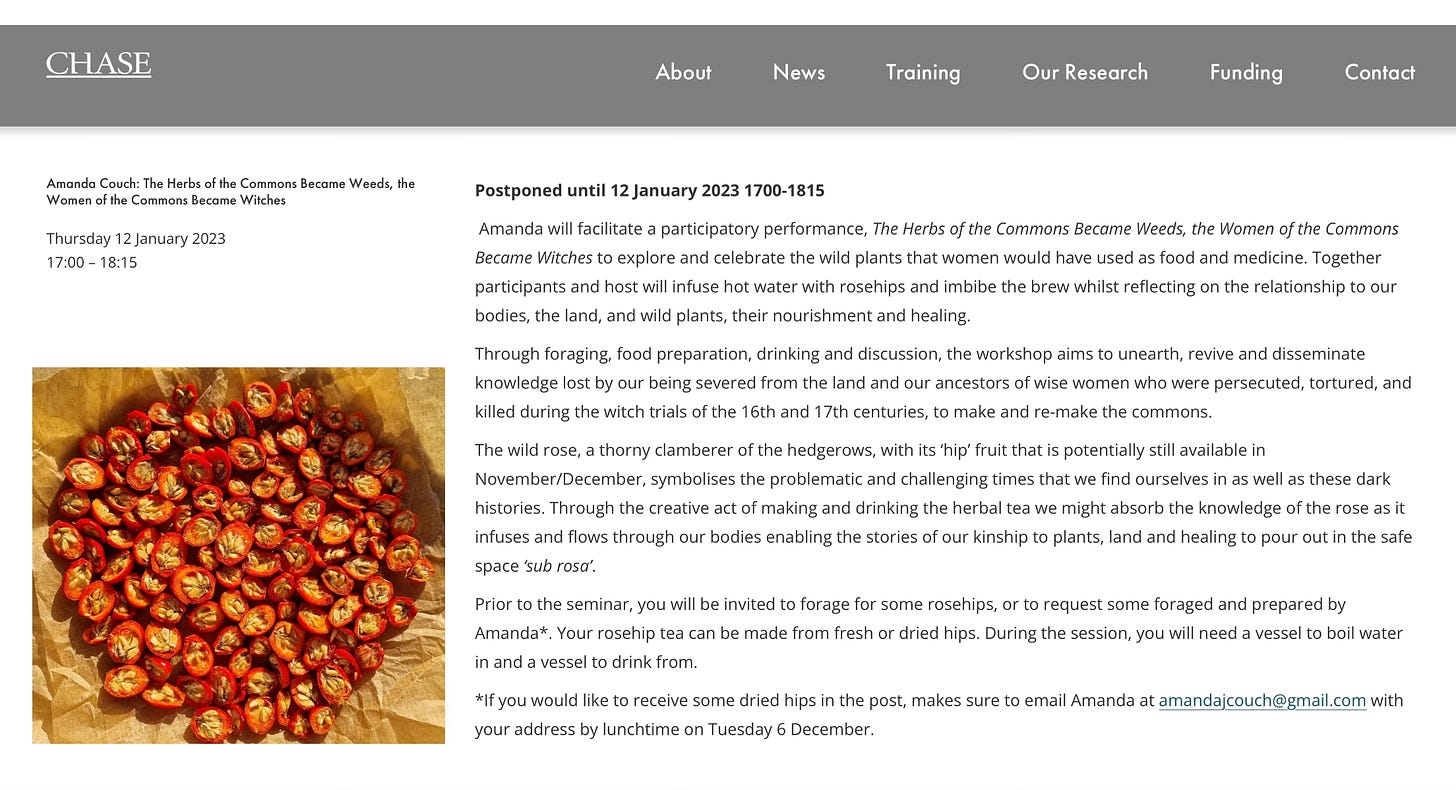Herbal Tea: February 2025’s Commons Feast Virtual Monthly Meet-up introduction
Dictamo, Weed Day, Bergtee (mountain tea) Association & The Herbs of the Commons Became Weeds, the Women of the Commons Became Witches workshop
This is the introductory text delivered at February 2025’s Commons Feast Virtual Monthly Meet-up on Tuesday 18 February:
Herbal infusions are perhaps the way in which we most often consume wild ingredients such as teas or tisanes. I also use them in soups, and stews, as the liquid for cooking grains, and in bread. My first encounter with a wild herbal tea was in Crete, where I drank dictamo, Greek mountain tea. Origanum Dictamnus is considered a panacea, for, according to both Aristotle and Theophrastus, even goats go looking for it if they have been wounded for it can eject arrows from the body! Although perhaps because it has been over picked, this now rare kind of oregano only found in the mountains of Crete, has been used to heal across literature from Virgil’s Aeneid (29-19 BCE), Baudelaire’s ‘Tout Entière’ (All Together) (1857) to Harry Potter and the Deathly Hallows (2007)!

Through their collaborative duo Weed Day, Taiwanese artists Zo Lin and Tiffany Lay explore the disappearing culture of herbal tea. Whilst undertaking temporary jobs around Taiwan, Lin found herself on a farm weeding and it dawned on her that people had lost the connection with the unwanted plants she was pulling up which they no longer recognised. Later she met artist and herbalist, Lay and they began collaborating as Weed Day in 2019. Grasslands the “brick and mortar manifestation” of their expanded art practice (Wei, 2021) in the historical tea trading district, Dadaocheng, came about after participating in several artist residencies, with the desire to become rooted in a particular place, to build community. As well as selling tea, they create exhibitions, events and educational workshops at Grasslands, and recently started ‘“adopting’ public green spaces around Taipei” leaving the weeds to grow without the use of pesticides to create a space for their local community “to observe, forage, and use [the] plants” (An-Jen Liu 2023).
In their practice, Weed Day shifts the focus from weeds being “a useless nuisance to be eradicated” to medicinal and nutritious herbs that can support health and wellbeing (Lin and Chao, 2021:392). For Weed Day “tea-making with weeds amounts to a biodiversity project and a protest at herbicide abuse that’s polluting the land” (2021:391). We might conceive that Weed Day responds to and resists what philosopher, Michael Marder in his 2013 book Plant Thinking: A Philosophy of Vegetal Life calls our "tak(ing) plants for granted" (2013:4). He writes that plants “flourish on the edge or at the limit of phenomenality, of visibility" (Marder, 2013:9) and this is especially true of weeds. In Weed Day’s practice, Lin and Lay actively re-visualise marginalised forgotten plants placing them front and centre of their practice.
Gathering plants for herbal tea is a popular way for many to use wild foraged plants is explored in an article in the Journal of Ethnobiology and Ethnomedicine ‘Gathering “tea” – from necessity to connectedness with nature’. In the paper, Susanne Grasser, Christoph Schunko & Christian Vogl document the uses of herbal teas and the guidelines for gathering plants through the Bergtee (mountain tea) association project in the Biosphere Reserve Grosses Walsertal in the Austrian Alps. Researchers found that “plants used for herbal tea were often named first when respondents were asked about plant species gathered in the wild within the nutrition category [for] drinking applications” (7 & 15). The researchers speculate that this might be because the “understanding of the term ‘tea’, expressed in the local turn of phrase in the Walser dialect ‘Gö mr gi te sammla’ is literally translated as ‘Let’s go and collect tea’” (15). Therefore, it seems that foraging wild plants is synonymous with picking plants for tea (15).

The women of the Bergtee project continue what their ancestors practised, “pass[ing] on knowledge about plants from generation to generation [… who] knew all about the relevance of the position of the sun, phases of the moon, times for gathering, habitats and air quality” (2012:16). They “cultivate this knowledge, pass it on and take it into account when they gather herbal plants for tea” (2012:16). Their informal instructions passed on orally guide their foraging practices and educate their pickers and processors. Like Weed Day,--who blends mixes of herbs, as Lay believes that “too much of anything […] is never a good thing” (Wei 2021)-- the Bergtee project includes seven different species framed by “a traditional saying that no illness will come near when you drink a seven-plant blend” (2012:17).
In January 2023, invited by writer and researcher Jane Hartshorn, I delivered an online workshop for the CHASE Medical Humanities Research Network called The Herbs of the Commons Became Weeds, the Women of the Commons Became Witches1 to explore and celebrate the wild plants that women would have used as food and medicine. I shared an introductory text, and participants, before the session, either foraged for or requested to be sent rosehips to make tea in the session. Together we infused them in hot water. Simultaneously we observed the colour of the liquid that changed from clear to a pale orange-pink as the hips imparted their antioxidant flavonoids. We took in the aroma of the tea with deep breaths. I asked, What comes to your attention? How does it smell? Do you experience any sensations in your body or are any feelings or images evoked?' Before imbibing the brew, I asked what the rose might be telling us as it infused our bodies. “As it flows down our windpipe, to warm, calm and relax us. Can we allow it to help initiate an ‘openness’ in opposition to the acts of enclosure, privatisation and the fencing off of communal land?” Drawing on the Ancient Roman link between roses and secrecy, I asked whether the hips might reveal something that has hitherto been hidden, or concealed. Bridging a ruptured link? Bringing us back to our bodies, the land, and kinship with wild plants, their nourishment and healing?
We then shared reflections where, for example, the tea evoked childhood memories of being given rosehip tea and syrup, and one participant responded in the chat that “meditation with tea has been so commodified and commercialised by tea companies that it feels very freeing to be giving attention to a tea outside the market economy” (Workshop participant, 2023).
So I am going to pause here, to hear from the floor where we might contemplate the meaning of the word ‘infusion’ from the early fifteenth century, Old French ‘"injection" or Latin infusionem meaning ‘a pouring in [or] that which is poured in’ (Etymonline, 2025) and ask:
What substances, herbs, ideas, practices would you like to invite to pour into you?
What was the gateway plant/fungi or means of imbibing that got you into foraging for wild foods?
Was herbal tea your gateway to consuming wild foods? If not, what was it? And if it was what were your first flavours?
What are your favourite flavours or blends? How do you make your blends? What guides you?
References:
An-Jen Liu, A (2023) In the Weeds: Art Collective 雜草稍慢Weed Day on Shaping Spaces For Ecological Education In: Mold 03/03/2023 At: https://thisismold.com/space/in-the-weeds-with-zo-lin-and-tiffany-lay(Accessed 17/02/2025).
Etymonline (2025) ‘Infusion’ At https://www.etymonline.com/search?q=Infusion (Accessed 17/02/2025).
Grasser, S., Schunko, C. and Vogl, C. R. (2012) ‘Gathering “tea” – from necessity to connectedness with nature. Local knowledge about wild plant gathering in the Biosphere Reserve Grosses Walsertal (Austria)’ In: Journal of Ethnobiology and Ethnomedicine, 8:31 At: http://www.ethnobiomed.com/content/8/1/31 (Accessed 17/02/2025).
Hayes, N. (2021) The Book of Trespass: Crossing the Lines that Divide Us London: Bloomsbury
Marder, M. (2013) Plant Thinking: A Philosophy of Vegetal Life New York: Columbia University Press.
Wei, C. (2021) ‘These Women Are Encouraging Taipei To Eat Its Weeds’ In: The News Lens International Edition 18/04/2021 At: https://international.thenewslens.com/article/149814 (Accessed 17/02/2025).
Wikipedia (2025) ‘Origanum dictamnus’ At https://en.wikipedia.org/wiki/Origanum_dictamnus (Accessed 17/02/2025).
Zo Lin, Z. and Chao E-C. (2021) ‘Weeds are Herbs: Botanic Arts of Foraging, Classifying, and Cooking’ In: East Asian Science, Technology and Society: An International Journal 15:3, (391-394), At: https://doi.org/10.1080/18752160.2021.1963096 (Accessed 17/02/2025).
The title of the workshop was taken from a line in Nick Hayes’ The Book of Trespass, p.167.




